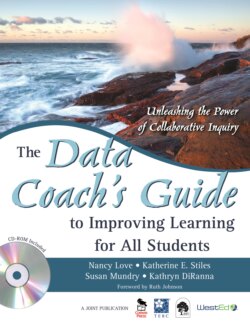Читать книгу The Data Coach's Guide to Improving Learning for All Students - Katherine E. Stiles - Страница 29
Multiple Entry Points: It’s Not as Linear as It Looks!
ОглавлениеFor all readers, we recommend starting with Chapters 1 and 2 to become familiar with the Using Data Process and learn about the role of the Data Coach. From then on, there are multiple pathways through the book. The authors created a comprehensive, sequential, and structured process because the Data Coaches we worked with found it valuable. But every context is different. Use this book with your context in mind and find the best fit between your purpose and our product. For most people, this will not be a sit-down-and-read cover-to-cover book.
For example, if you are taking on the role of Data Coach and want to follow the entire process, here is a possible course: After reading Chapters 1 and 2, scan Chapters 3–7, reviewing the components of the Using Data Process and the procedures for implementing the 19 tasks and the associated activities. Then consult the CD-ROM for other materials relevant to the tasks. As you prepare to implement each task, it will be important to read all of the material related to that task in detail. For the first time through, we suggest working through the tasks in order. It is not necessary or even recommended, however, to conduct all activities for all tasks for every Data Team. Instead, customize the process by considering the knowledge, skills, beliefs, and experiences of your Data Team and the time and data available. The guide includes a variety of assessments of data literacy and school practices that will help you tailor your own approach to these materials.
Another pathway through the book is for readers who already have an established continuous improvement process in place in their schools. You can use this guide to strengthen that process by implementing specific components of the Using Data Process. For example, your Data Teams may want to go directly to the “Verifying Causes” chapter (Chapter 5) if that is a stage you have been overlooking. Other readers may be looking for ways to bring equity issues to the forefront of school improvement work. For this, Chapter 3 (“Building the Foundation”) is a good place to start, especially Task 3 (Raise Awareness of Cultural Proficiency). Then you can use the Equity Lens icons to follow how cultural proficiency and equity are woven throughout the process.
For those who prefer to see the whole picture before getting into the details, consider starting off by reading Chapter 8, the case study about Clark County, Nevada. Finally, some readers may want to go directly to the Toolkit on the CD-ROM and scan for specific tools to use with their Data Teams or faculty. Whatever pathway you take, please use this guide to inspire your own creativity and to unleash the power of collaborative inquiry to make a better future for each and every student.
